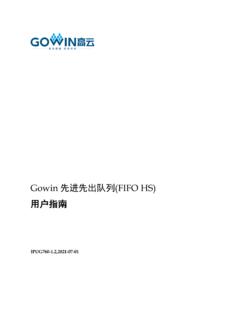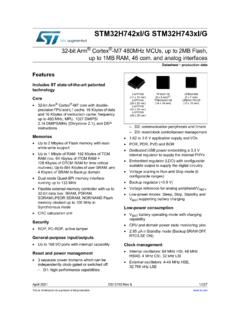Transcription of AXI UART 16550 v2 - Xilinx
1 AXI UART 16550 IP Product GuideVivado Design SuitePG143 October 5, 2016 AXI UART 16550 October 5, of ContentsIP FactsChapter 1: OverviewFeature Summary.. 6 Licensing and Ordering Information .. 7 Chapter 2: Product SpecificationPerformance .. 8 Resource Utilization .. 9 Port Descriptions .. 10 Register Space .. 12 Interrupts .. 24 Chapter 3: Designing with the CoreClocking.. 26 Resets .. 26 Programming Sequence.. 26 Chapter 4: Design Flow StepsCustomizing and Generating the Core .. 29 Constraining the Core .. 31 Simulation .. 32 Synthesis and Implementation .. 32 Chapter 5: Example DesignOverview .. 33 Implementing the Example Design .. 34 Example Design Directory Structure .. 34 Simulating the Example Design.
2 35 Send FeedbackAXI UART 16550 October 5, 6: Test BenchAppendix A: Migrating and UpgradingMigrating to the Vivado Design Suite .. 37 Upgrading in the Vivado Design Suite .. 37 Appendix B: DebuggingFinding Help on .. 38 Vivado Design Suite Debug Feature .. 39 Hardware Debug .. 39 Appendix C: Additional Resources and Legal NoticesXilinx Resources .. 40 References .. 40 Revision History .. 41 Please Read: Important Legal Notices .. 41 Send FeedbackAXI UART 16550 October 5, SpecificationIntroductionThe LogiCORE IP AXI Universal Asynchronous Receiver Transmitter (UART) 16550 connects to the Advance Microcontroller Bus Architecture (AMBA ) AXI and provides the controller interface for asynchronous serial data transfer. This soft IP core is designed to connect through an AXI4-Lite AXI UART 16550 detailed in this document incorporates features described in the PC16550D Universal Asynchronous Receiver/Transmitter with FIFOs Data Sheet [Ref 1].
3 The PC16550D data sheet is referenced throughout this document and should be used as the authoritative specification. Differences between the PC16550D and the AXI UART 16550 product guide are highlighted in Interrupts in Chapter AXI4-Lite interface for register access and data transfers Hardware and software register compatible with all standard 16450 and 16550 UARTs Supports default core configuration for 9600 baud, 8 bits data length, 1 stop bit and no parity Implements all standard serial interface protocols 5, 6, 7 or 8 bits per character Odd, Even or no parity detection and generation 1, or 2 stop bit detection and generation Internal baud rate generator and separate receiver clock input Modem control functions Prioritized transmit, receive, line status and modem control interrupts False start bit detection and recover Line break detection and generation Internal loopback diagnostic functionality 16 character transmit and receive FIFOsIP FactsLogiCORE IP Facts TableCore SpecificsSupported Device Family(1)UltraScale+ UltraScale Zynq -7000,7 SeriesSupported User InterfacesAXI4-LiteResourcesSee Table with CoreDesign FilesVHDLE xample DesignVHDLTest BenchVHDLC onstraints FileXilinx Design Constraints (XDC) FileSimulation ModelNot ProvidedSupported S/W Driver(2)Standalone and LinuxTested Design Flows(3)Design EntryVivado Design SuiteSimulationFor supported simulators, see theXilinx Design Tools: Release Notes SynthesisSupportProvided by Xilinx at the Xilinx Support web pageNotes.
4 A complete list of supported devices, see the Vivado IP driver details can be found in the software development kit (SDK) directory<install_directory>/SDK/<release>/data/embeddedsw/ OS and driver support information is available from the Xilinx Wiki For the supported versions of the tools, see the Xilinx Design Tools: Release Notes FeedbackAXI UART 16550 October 5, 1 OverviewThe AXI UART 16550 IP core implements the hardware and software functionality of the PC16550D UART, which works in both the 16450 and 16550 UART modes. For complete details, see the PC16550D Universal Asynchronous Receiver/Transmitter with FIFOs data sheet [Ref 1].The AXI UART 16550 core performs parallel-to-serial conversion on characters received from the AXI master and serial-to-parallel conversion on characters received from a modem or serial peripheral.
5 The AXI UART 16550 is capable of transmitting and receiving 8, 7, 6, or 5-bit characters, with 2, or 1 stop bits and odd, even or no parity. The AXI UART 16550 can transmit and receive AXI UART 16550 core has internal registers to monitor its status in the configured state. The core can signal receiver, transmitter, and modem control interrupts. These interrupts can be masked and prioritized, and they can be identified by reading an internal register. The core contains a 16-bit, programmable, baud-rate generator, and independent, 16-character-length transmit and receive FIFOs. The FIFOs can be enabled or disabled through top-level block diagram for the AXI UART 16550 core is shown in Figure Target - Figure 1-1 Figure 1-1:UART 16550 Block Diagram AXI InterfaceUART 16550 RegistersBRGRX ControlTX ControlInterrupt ControlRXTXI nterruptUART ControlReceive Data FIFOT ransmit Data FIFOS tatus Register(STAT_REG)Control Register(CTRL_REG)AXI4-LiteInterfaceX144 48 Send FeedbackAXI UART 16550 October 5, 1:OverviewThe AXI UART 16550 modules are described in these sections: AXI Interface: This block implements the AXI4-Lite slave interface for register access and data transfer.
6 UART Control: This block consists of the following. RX Control This block samples received data with respect to generated baud rate and writes it to Receive Data fifo . TX Control This block reads data from Transmit Data fifo and sends it out on UART TX interface. BRG (Baud Rate Generator) This block generates various baud rates that are user programmed. Interrupt ControlThe AXI UART 16550 core provides separate interrupt enable and interrupt identification registers. If interrupts are enabled, a level-sensitive interrupt is generated for the following conditions. See Interrupts in Chapter 2 for more line status-Received data available-Character timeout-Transmitter holding register empty-Modem statusFeature Summary AXI4-Lite interface for register access and data transfers Hardware and software register compatible with all standard 16450 and 16550 UARTs Supports default core configuration for 9600 baud, 8 bits data length, 1 stop bit and no parity Implements all standard serial interface protocols 5, 6, 7 or 8 bits per character Odd, Even or no parity detection and generation 1, or 2 stop bit detection and generation Internal baud rate generator and separate receiver clock input Modem control functions Prioritized transmit, receive.
7 Line status and modem control interruptsSend FeedbackAXI UART 16550 October 5, 1:Overview False start bit detection and recover Line break detection and generation Internal loopback diagnostic functionality 16 character transmit and receive FIFOsLicensing and Ordering InformationThis Xilinx LogiCORE IP module is provided at no additional cost with the Xilinx Vivado Design Suite under the terms of the Xilinx End User License. Information about this and other Xilinx LogiCORE IP modules is available at the Xilinx Intellectual Property page. For information on pricing and availability of other Xilinx LogiCORE IP modules and tools, contact your local Xilinx sales FeedbackAXI UART 16550 October 5, 2 Product SpecificationPerformanceThe AXI UART 16550 is characterized as per the benchmarking methodology described in Appendix A, IP Characterization and FMAX Margin System Methodology, Vivado Design Suite User Guide: Designing With IP (UG896) [Ref 2].
8 Table 2-1 shows the results of the characterization :Frequency data for UltraScale and Zynq -7000 devices are expected to be similar to 7 series device 2-1:Maximum FrequenciesFamilySpeed GradeFmax (MHz) for AXI4-LiteVirtex-7-1180 Kintex-7180 Artix-7120 Virtex-7-2200 Kintex-7200 Artix-7140 Virtex-7-3220 Kintex-7220 Artix-7160 Send FeedbackAXI UART 16550 October 5, 2:Product SpecificationResource UtilizationThe AXI UART 16550 resource utilization for various parameter combinations measured with three architectures is shown in Table 2-2:Resource Estimations for 7 Series, Zynq, and UltraScale DevicesUART ModeUse External Clock for Baud RateEnable External Receiver ClockSlices/CLBR egistersLUTsUltraScale165501168318342165 5000653083451645000522592627 Series and Zynq165501112031835216550001183083471645 00082259252 Send FeedbackAXI UART 16550 October 5, 2:Product SpecificationPort DescriptionsThe I/O signals are listed and described in Table 2-3:I/O SignalsSignal NameInterfaceSignal TypeInitial StateDescriptionSystem Signalss_axi_aclkSystemI-AXI Clocks_axi_aresetnSystemI-AXI Reset signal, active-Lowip2intc_irptSystemO0 Device interrupt output to microprocessor interrupt input or system interrupt controller (active-High)freezeSystemI-This is used to freeze the UART.
9 When pulled High, the interrupts are disabled and the internal state machine goes into idle *S_AXI--See Appendix A of the Vivado AXI Reference Guide (UG1037) [Ref 3] for description of AXI4 Interface SignalsbaudoutnSerialO116 x clock signal from the transmitter section of the UART rclkSerialI-Receiver 16x clock (Optional, can be driven externally under control of the Enable External Receiver CLK parameter)sinSerialI-Serial data inputsoutSerialO1 Serial data outputxinSerialI-Baud rate generator reference clock (Optional, can be driven externally under control of the Use External CLK for BAUD Rate parameter)xoutSerialO0If Use External CLK for BAUD Rate = 0, Xout is 0, if Use External CLK for BAUD Rate = 1 Xout can be used as reference feedback clock for Baud rate generator ctsnModemI-Clear to send (active-Low).
10 When Low, this indicates that the MODEM or data set is ready to exchange carrier detect (active-Low).When Low, indicates that the data carrier has been detected by the MODEM or data set ready (active-Low).When Low, this indicates that the MODEM or data set is ready to establish the communication link with the FeedbackAXI UART 16550 October 5, 2:Product SpecificationdtrnModemO1 Data terminal ready (active-Low).When Low, this informs the MODEM or data set that the UART is ready to establish a communication indicator (active-Low).When Low, this indicates that a telephone ringing signal has been received by the MODEM or data to send (active-Low).When Low, this informs the MODEM or data set that the UART is ready to exchange disable. This goes Low when CPU is reading data from UART.













